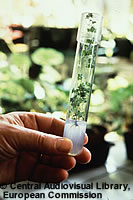EU round table dialogue aims to bridge GMO debate 'extremes'
European Research Commissioner Philippe Busquin has said that more must be done to ensure that research on GMOs' (genetically modified organisms) safety reaches the European public in order to calm irrational fears and pave the way for a balanced debate on the issue. Speaking at the launch of a European round table on GMO safety research in Brussels on 9 October, Commissioner Busquin said that 15 years of Commission-sponsored research on GM safety had uncovered no significant evidence of danger. Quoting the old adage 'no news is good news,' Busquin nonetheless said that this very lack of evidence of harmful GM effects rarely reached the public debate as politicians and scientists 'like to be at the heart of the news.' Presenting a newly-published review of EC-sponsored research on the safety of GMOs he said that the research work, carried out under EU RTD Framework programmes between 1985 and 2000, was nonetheless essential as 'such long-term work, undertaken by independent scientists and supported by public funding, is essential to reinforce public confidence in the regulatory framework' and in the use of GM products in foodstuffs, vaccines and agricultural trials. Mr Busquin said that the body of research work carried out since 1985 and work currently underway under the 'Quality of life and management of living resources' programme of the Fifth Framework programme (FP5) aimed to counter criticism of a lack of knowledge of any potentially harmful effects of GM technology. 'The main objective of this study is to show how the European Commission has confronted this demand, and demonstrate our efforts to construct a community of researchers to contribute to the rapid accumulation of knowledge and experience in this area.' He said this research work had been adapted to take into account the hypothetical risks of GM produce, adding: 'We are faced with numerous regulatory demands and moratoria which are out of sync with the challenges, opportunities or circumstantial risks of modern biotechnology.' Professor Phil Dale, of the John Innes Institute of Plant Science Research in the UK, also called for a reasoned approach to the biosafety debate. 'Some scientists argue GM crops can save and feed the world,' he said. 'I don't believe that but I believe they are an important tool on the plant breeder's box.' He added that a polarised debate on the issue was unhelpful, explaining: 'GM crops are neither innately good nor bad - the challenge is how we use them.' He said, for example that if the use of GM crops encourages more monoculture in agricultural practice, this could have a negative effect on the environment, 'but if there is much more targeted control of pests, diseases and weeds then there is the potential to increase biodiversity by improving the environment.' Professor Dale said that GM pest control could go some way to reducing the quantity of agrochemical sprays in Europe, of which 30,000 tonnes are used annually in the UK alone. Professor Dale also outlined areas for future biosafety research which emerged from the workshop. One of these is the issue of environmental monitoring of GM produce, for a fixed number of years under the 2001/18/EC Directive, which is on target for implementation next year. Proposals were discussed for the implementation of commercial monitoring of new GM products for a period of several years, the precise length of which would be dictated by an initial scientific assessment of the product. He said that further research on the issue of GM pollination of non-GM or organic crops and seed mixing was also discussed. Although the organic movement would like zero contact between GM and non-GM crops, Professor Dale said, it is impossible to guarantee 100 per cent seed purity. 'This is not about safety,' he emphasised, 'this is about providing consumers with a product which is as true to what they think the are buying as possible.' He said that in deciding levels of tolerance, analytical accuracy and errors in sampling need to be taken into account. How much consumers are willing to pay must also be considered, as extra controls translate into extra cost. Reporting back on the workshops on genetically modified Bt maize, he said that after going through the evidence for 'millions and millions of hectares' of Bt corn, the only adverse evidence found is of a negative effect on Monarch butterflies. Professor Dale said this problem could easily be remedied, while the wider agricultural opportunities presented by Bt corn are enormous. He said work is currently underway to examine the long-term effect of Bt proteins, which remain in the soil for a long time after a Bt crop has been grown, on soil-borne organisms. He said the evidence produced so far showed no signs of adverse effects, adding that the Bacillus Thuringiensis, from which the pest-killing toxin expressed in Bt corn is derived, is a ubiquitous bacteria found as far afield as the Antarctic. Professor Dale said it was not enough to rely on market forces alone for the introduction of GM crops, and that farmers needed incentives to introduce GM crops. 'There is a wind of change within Europe, moving from mass production to producing a crop in a particular way,' he explained. One aspect of this change, he said, is that farmers are increasingly perceived as stewards of the environment, with a specific role to play other than large-scale food production. Professor Dale also said he agreed with a recent call from Health and Consumer Protection Commissioner David Byrne and Agriculture Commissioner Franz Fischler for more proactive political leadership by EU governments on the issue of GMOs. The round table was launched as part of a wider consultative exercise being carried out by the Commission in the run up to the production of a Communication outlining a strategic vision for life sciences and biotechnology in Europe, which is to be completed by the end of the year.

